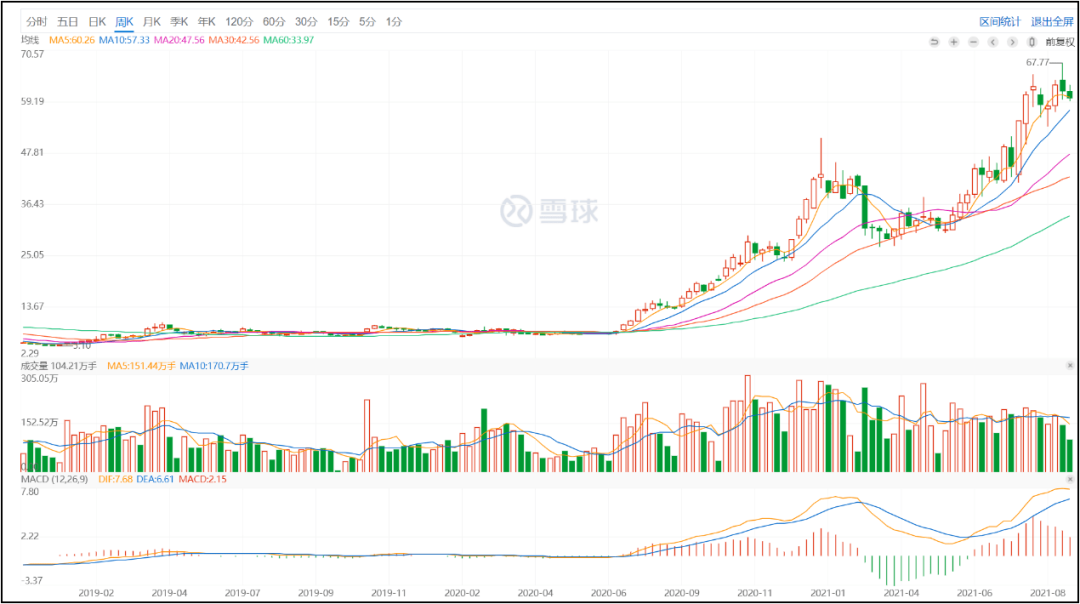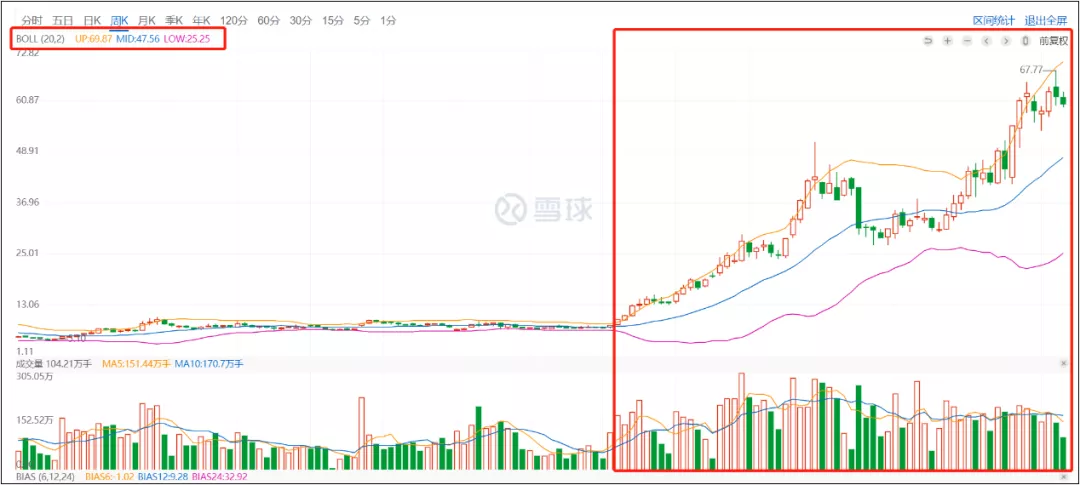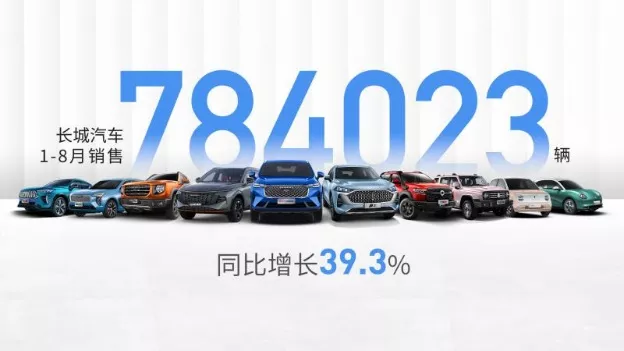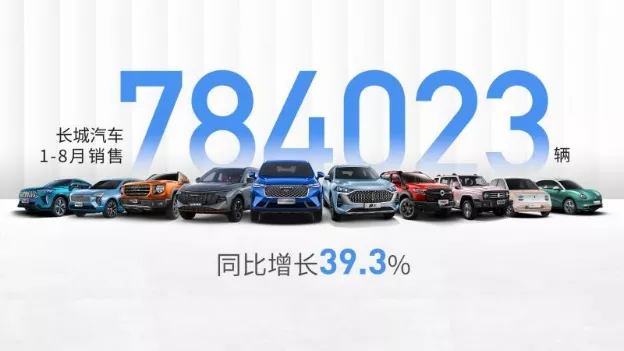This article is reproduced from the Autocarweekly WeChat account.
Author: Financial Street Old Li
Unknowingly, Great Wall Motors has already reached 500 billion, can it break through 1 trillion?
In early June of this year, Old Li talked with everyone about Great Wall Motors in an article titled “When will the once 300 billion Great Wall Motors return to its peak?” (https://www.42how.com/post/3137). At that time, Great Wall Motors was in a significant post-holiday decline and was not favored by many due to the rapid decline of many new energy car stocks in Q2. However, Great Wall Motors has been hovering around RMB 30 for a long time, and many friends have insufficient confidence in the low position of Great Wall Motors.

Soon after the conversation, Great Wall Motors began a substantial rise. Over the past three months, Great Wall Motors’ performance has been outstanding: from RMB 250 billion in June, it has soared all the way to RMB 500 billion, and is still 500 billion behind BYD, the leader of A-share automobile companies, in terms of market value.
Today, Old Li will talk with everyone about Great Wall Motors again, discussing recent changes and why Great Wall Motors’ valuation is becoming more like that of BYD. How will Great Wall Motors develop in the coming months?
What Has Happened in the Past Three Months?
In May, Old Li mentioned that securities companies had been working hard to promote Great Wall Motors last year, and this year they continued to do so. From the bottom built in June to early September, Great Wall’s stock price has been rising, with two core factors: first, the automobile industry is in good condition, and second, the performance of Great Wall Motors in Q2 and Q3 has been very good.
When Old Li discussed Great Wall at the end of May, many institutions were conducting research on the company. Wei Jianjun, the Great Wall’s chairman, also took the opportunity to market it. With the support of strong performance, Great Wall set its sights on hitting 4 million units in 2025, and the capital market bought into the idea, accelerating the rise of the stock price.
The truth of the rise in the secondary market is that everyone buys together. At the beginning of the year, GAC Aion proposed the concept of graphene-based batteries. While many fund managers knew that the hype around this technology was greater than its reality, they still quickly bought in, resulting in a rapid surge in stock prices. The logic for Great Wall Motors is similar, only it is playing a long game…
The sources of information in the secondary market are often more sensitive and ahead of the industry. At the end of May, many analysts predicted that Great Wall Motors would have a good market performance in the first half of this year, and quietly bought in, setting off this round of pre-rise. After Great Wall released its mid-term performance report on July 20, the stock price accelerated even further, with many major secondary market funds buying in and hitting the daily limit the following day.
According to analytical practices, let’s review Great Wall Motors’ performance in the first half of the year:Sales Performance: Great Wall Motors sold a total of 618,211 vehicles with a YoY growth of 56.5%, including 61,672 units sold overseas with a YoY growth of 200.3%, accounting for nearly 10% of the overall sales.
In terms of different car types, the sales volume of pickups, SUVs, and sedans (mainly new energy vehicles of the Euler brand) in the first half of the year were 114,000 units, 447,000 units, and 53,000 units respectively, with YoY growth of 12.3%, 55.9%, and 373.4%; while in terms of different brands, the sales volume of Haval, WEY, Euler, and Great Wall pickups in the first half of the year were 389,000 units, 23,000 units, 53,000 units, and 114,000 units respectively, with YoY growth of +48.6%, -14.8%, +428.7% and +12.3%.
It’s worth noting that the Haval H6 has won the domestic SUV sales champion for 97 consecutive months, with a total sales volume of 196,685 units, a YoY growth of 61.5%, in the first half of the year; while the sales volume of the high-end off-road SUV Tank 300 in the first half of the year was 34,000 units.
All these sales figures are analyzed to highlight the diversity of their products, which is one of the key reasons why the secondary market has a positive view on Great Wall Motors. In the past five years, the sales volume of Great Wall Motors has been fluctuating around the million level due to the single product strategy. Since 2020, the core purpose of Great Wall’s diversified product strategy is to break through the bottleneck of one million bottles.
Opportunities and risks coexist, with a diversified product portfolio, the importance of the flagship product cannot be ignored. If the Haval H6 fails to maintain its flagship status, it will seriously affect their valuation. Therefore, everyone should pay close attention to the performance of the Haval H6 every month.
Profit Performance: In the first half of the year, revenue was RMB 61.93 billion, a YoY increase of 49.7%/72.4%, and the pre-tax and after-tax net profits were RMB 3.53 billion and RMB 2.84 billion, respectively, a YoY increase of 207.9%/254.2% and 132.6%/129.0%, respectively.
It’s worth noting that Q2 revenue was RMB 30.81 billion, a YoY increase of 64.3%/31.0%, while net profit attributable to shareholders of the parent company was RMB 1.89 billion, a YoY increase of 154.0%/5.2%, and an increase of 15.2% QoQ; the non-recurring net profit attributable to shareholders of the parent company was RMB 1.51 billion, a YoY increase of 152.1%/-2.9%, and an increase of 12.8% QoQ. Q2 indicators performed better than Q1.# Financial Indicators of Great Wall Motor Company
Overall, the financial indicators of Great Wall Motor Company are better than those of the previous two years. This is different from other companies in the industry. Many companies are trying to game the system and appear to have better results in the first half of 2021 than in the same period of the previous year (due to the low base caused by the pandemic). However, their actual performance is worse than in 2019.
Great Wall Motor Company is an exception. The figures do not lie. Despite the significant decline in the proportion of monthly sales of fuel vehicles in the first half of this year, Great Wall Motor Company’s performance was relatively outstanding.
Apart from the boost in sales, Great Wall Motor Company’s high unit volume mainly comes from new brands and products. According to official data, the sales of the Tank and Pika brands, which have high selling prices and profits, rose by about 2.5-3.5% MoM, driving the overall gross profit margin and net profit improvement. In terms of per-vehicle income, Great Wall Motor Company reached a unit income of 111,100 yuan in Q2, a MoM increase of 20.96%, while in terms of per-vehicle profit, Q2 reached 6,700 yuan, a MoM increase of 37.53%.
Performance is the most fundamental driving force for the company’s valuation growth.
Gradually Changing Valuation Logic
Since last year, Li (Chairman of Great Wall Motor Company) has been emphasizing that the most popular automotive targets in the secondary market are BYD. In one year, BYD’s market value has moved from the 500 billion club to the 800 billion club and the trillion club, entering the top 10 market capitalization of A shares.
Recently, Li has been emphasizing that Great Wall Motor Company is becoming more and more like BYD. This view should be viewed from the perspectives of the industry and capital.
From an industrial perspective, the two seem to have no direct relationship. One focuses on the new energy sector, and the other focuses on the fuel vehicle sector. In the present and the future, Great Wall Motor Company cannot compare with BYD. From a capital perspective, Great Wall Motor Company is indeed stepping closer to BYD.
What is BYD’s core competitiveness? In short, there are two points. First, BYD firmly grasped the smart electric vehicle main track. When people hear the name BYD, they immediately think of new energy. Second, BYD firmly grasped the core link of the industrial chain. BYD focuses on the critical technology that can easily be a bottleneck in the industry chain, such as power batteries, semiconductors, and wire control components. All of BYD’s layouts firmly capture the appetite of capital.
Great Wall Motor Company’s layout ideas have similarities and differences with BYD, but the main line is the same: the main track + industrial chain.
To describe Great Wall Motor Company in a semi-official language:
In the new stage of the transformation towards global tech mobility companies in the electric, intelligent, and connected revolution of the automotive industry, Great Wall Motor has relied on organizational changes to form four core competencies: core technology stack self-research, diverse product definition capability, multi-brand user coverage, and continuous innovation in marketing models. This has driven the self-research of a full-stack technology stack in intelligent cockpit, driving, line control chassis, EE architecture, batteries, DHT hybrid, and hydrogen energy with five brands, Haval, Pickup, WEY, ORA, and Tank, moving forward comprehensively.
Unpacking core competencies, core technology stack self-research is both the core and most similar feature of Great Wall Motor to BYD. Looking at the overall technological roadmaps of both companies, Great Wall Motor is currently largely focused on fuel-based technology as well as hybrid and electric vehicles, whereas BYD mainly focuses on pure electric and hybrid vehicles while also considering fuel-based cars. However, looking at the future, as long as market trends change, Great Wall Motor will quickly follow BYD’s roadmap. The term “core technology stack self-research” can also be extended to mean that Great Wall Motor has managed to stitch together critical points in these technology roadmaps, making it a reason why the secondary market is bullish about Great Wall Motor.
At present, Great Wall Motor is a “good student” but has not yet become the “learning model” of the industry like BYD. From traditional fuel-based vehicles to new energy vehicles, from complete cars to the industry chain – electric, intelligent, connected, and shared, Great Wall Motor is laying out in every direction, not leaving anything out, regardless of whether they succeed or not.
Among these plans, Honeycomb Energy and Unis Energy are short-term winners, while components are a medium-term plan and the long-term plan could be energy storage.
Honeycomb Energy, formerly the power battery division of Great Wall Motor, mainly focuses on the lithium battery industry chain. In 2018, Honeycomb Energy was adjusted from the Great Wall Motor system to Great Wall Holdings and became a brother company alongside Great Wall Motor. Unis Energy is primarily responsible for the hydrogen energy sector and is tasked with promoting the hydrogen and fuel cell industry chain.
In addition to the new focus on Honeycomb Energy and Unis Energy, Great Wall Motor has four major component companies in its supply chain: Honeycomb E-Create, Nobe Auto, Jinggong Auto, and Mand Digital. The goal of these independent component companies is to promote independent and open access to component businesses, achieve market-driven operations, and enhance overall competitiveness.Overall, currently, Great Wall Motors’ auto parts sector still relies mainly on internal supply. However, with the exploration of the external market and the independent operation of various parts companies, Great Wall Motors’ auto parts revenue has achieved rapid growth. In the first half of this year, the revenue of Great Wall Motors’ auto parts business reached as high as CNY 6.72 billion, a year-on-year increase of approximately 70%. Leveraging its technical accumulation in the core components of fuel vehicles and new energy vehicles, relying on internal supply and external expansion, the auto parts sector is expected to become a new growth point.
Looking at it horizontally, it resembles a ridge, and viewed from the side, it looks like a peak. By changing the thinking path, the business of Great Wall Motors and BYD Auto is similar.
How Far is One Trillion?
Let’s start with the conclusion: although Great Wall Motors and BYD Auto are quite similar, Great Wall’s one trillion goal is still far away, even elusive.
In “When will the once CNY 300 billion Great Wall Motors return to its peak?”, Lao Li mentioned a method for judging a company’s short-term and long-term market value trend, i.e., short-term trend should focus on market sentiment, sector rotation, and company rotation, while long-term trend should focus on the company’s position on the track and fundamentals.
From a long-term perspective, Great Wall has both opportunities and risks in terms of performance and position.
In terms of performance, the sales growth rate of Great Wall Motors has remained high throughout Q3 this year, and Great Wall will definitely have a good third quarter report. However, the Q4 performance is unknown and depends on supply and demand. Last year’s Q4 auto market had a high base, and this year, the chip shortage combined with economic downturn, Great Wall Motors’ market performance in Q4 is an unknown variable. Lao Li will continue to pay attention to Great Wall Motors’ monthly performance.

In terms of the position, Great Wall’s multi-brand strategy has already taken positions in various technology routes, among which Tank and Euler are the most noteworthy.
In terms of fuel vehicles, the Haval brand and the pickup brand perform steadily and are unlikely to experience major ups and downs. The high-end positioning of the WEY brand is basically stagnant. The only one that can improve expectations is the Tank brand, and its performance will determine Great Wall Motors’ single-vehicle gross margin and affect valuation. In plain terms, if Tank performs well, the secondary market will consider Great Wall to be more valuable.
In terms of new energy, it mainly depends on Euler’s performance. Over the past two years, Euler has inadvertently achieved good market performance, but the risk lies in its sustainability. If Great Wall wants to make a difference in the new energy field, relying solely on Euler is not enough. If there are no follow-up new energy products, once competitors arrive, Euler’s sales volume will inevitably be affected, and the secondary market’s expectations of Great Wall Motors in the new energy field will be greatly discounted.
 We take BYD as a reference object. Before the launch of the Beam brand and Salon Intellect, there is no hope that the current layout of the Great Wall Motor can reach a market capitalization of 1 trillion yuan.
We take BYD as a reference object. Before the launch of the Beam brand and Salon Intellect, there is no hope that the current layout of the Great Wall Motor can reach a market capitalization of 1 trillion yuan.
Many friends will ask, how to look at the short-term trend? To be honest, it is also difficult for Lao Li to give particularly good advice, because everyone has different positions and different perspectives. Three months ago, friends who bought Great Wall Motor are now making a lot of money, they can withstand withdrawals, while friends who buy Great Wall Motor now face the risk of withdrawals.

In the short term, will Great Wall Motor withdraw? Lao Li believes that it should be viewed from two aspects.
First, the market has confirmed the 500 billion yuan valuation of Great Wall Motor, and this high valuation is no problem. Q3 Great Wall has better performance support, and the company’s basic situation is no problem;
Second, the entire A-share market is in a high volatility period, and the volatility of stock prices is more common, and the rotational situation of the automotive sector will determine the trend of Great Wall.
Because Great Wall Motor has risen a lot in the past three months, there are probably two possibilities in the next step: if the trend of the automotive sector is good, Great Wall will basically maintain a shaking trend on the weekly K-line chart. If the trend of the automotive sector is not good, Great Wall is likely to be callback to the low position recognized by the market, and Lao Li personally prefers the first trend.
In Q4 of last year, the automobile stocks, which had been silent for many years, finally ushered in the spring. Under the offensive of the second-level market in the spring, many automobile stocks rose rapidly, and the market re-recognized automobile stocks. This year, driven by the new four modernizations, the market differentiated the automobile stocks. Some companies rose very well, while some companies basically did not move. Great Wall Motors is among the former. Next year, how will automobile stocks go, no one knows.

Unlike the industry, the research and judgment of companies in the secondary market is not a leap, but a gradual process of continuous tracking and continuous correction. Research itself is a kind of game. High winning rate naturally wins. This is probably the most fascinating part of the secondary market.
Lao Li also looks forward to the spring frenzy soon.
This article is a translation by ChatGPT of a Chinese report from 42HOW. If you have any questions about it, please email bd@42how.com.
